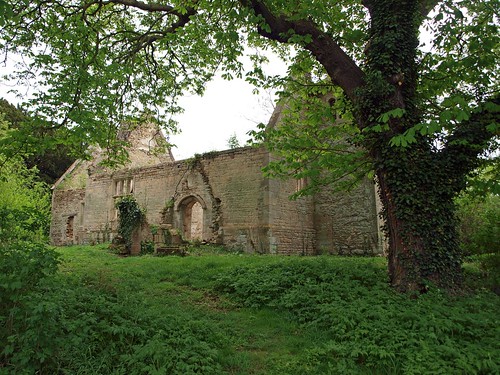ALL SAINTS. In ruins. It was essentially a C17 church. Nave and chancel, and a small, short SW tower. Certain minor old parts were re-used (e.g. the C13 chancel arch), but the windows - three lights with transom in the nave, two lights in the chancel - are of 1629, and the mouldings of the chancel arch responds too. The N porch (not the mouldings of the entrance) is of 1665 , the W tower of unknown date. The E window tracery looks c.1800. The work of 1629 was paid for by Sir Robert Cotton, the antiquary (cf. Conington), the work of 1665 by his grandson Sir John.
DENTON. From this tiny hamlet came one of England’s famous men, and Scotland’s Robert Bruce owned it. Bruce was patron of the living when he was Earl of Huntingdon.
The small church has a chancel arch 700 years old, but the rest of it was new in the 17th century. It has three old doors still swinging on their hinges, one with a big wooden lock, all made by carpenters who would hear the latest news of Cromwell. They may have made the altar table and the altar rails, and the old part of the canopy of the 18th century pulpit. Three bench-ends in the nave, one with fleur-dc-lys, were made in Shakespeare’s day, and there are two Elizabethan chalices.
Denton’s proud son is Sir Robert Cotton, an antiquarian famous in Europe. The house he was born in has gone and a barn has taken its place, but the font at which he was baptised in 1570 is here. He was one of the most learned men of his day, and his Library is now a priceless national possession. It was his boast that he descended from kings of Scotland who owned the land of this place. He lies amid much pomp at Conington.
The small church has a chancel arch 700 years old, but the rest of it was new in the 17th century. It has three old doors still swinging on their hinges, one with a big wooden lock, all made by carpenters who would hear the latest news of Cromwell. They may have made the altar table and the altar rails, and the old part of the canopy of the 18th century pulpit. Three bench-ends in the nave, one with fleur-dc-lys, were made in Shakespeare’s day, and there are two Elizabethan chalices.
Denton’s proud son is Sir Robert Cotton, an antiquarian famous in Europe. The house he was born in has gone and a barn has taken its place, but the font at which he was baptised in 1570 is here. He was one of the most learned men of his day, and his Library is now a priceless national possession. It was his boast that he descended from kings of Scotland who owned the land of this place. He lies amid much pomp at Conington.

No comments:
Post a Comment